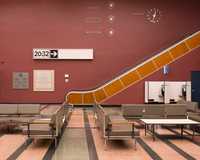Gander airport / Gander
Flying in style
Gander International Airport in Canada was once the largest and most stylish airport in the world, where locals mingled with celebrities. Today it faces a battle to hold on to its glamorous reputation – and its passenger numbers.
“She might be running a bit late today,” says Jerry Cramm, eyeing the runway outside from the vantage point of Gander International Airport’s striking terminal. The “she” in question is a tiny 18-seater beh twin-turboprop plane that Air Canada uses for its daily domestic flights between Gander and St John’s, a township about 350km southeast. During his 25 years at Gander, Cramm has seen umpteen behs and their more powerful transatlantic peers land and take off at the two runways currently in operation at the airport. And he has a story or two to share about the terminal’s glamorous past and, indeed, its quieter present.
Perched on the island of Newfoundland, the airport opened in 1938. It took about three years and a 900-person team to finish the project which, with its four paved runways and a combined area of 2.6 sq km, became the largest airport in the world. Less than two decades later, the airport was already known as the Crossroads of the World. All transatlantic flights would land here to refuel, allowing passengers en route from New York and London to stretch their legs. “The island was picked due to its location,” explains Cramm, now a chief commissionaire in charge of a six-strong security staff. “It is the easternmost part of Canada. The nature of the terrain was also very important – The Rock [as Newfoundland is known in Canada] was a vast, flat and virgin piece of land.”
Eventually, in the late 1950s, major renovations were necessary to accommodate the ever-growing influx of passengers. The ca$3m (€2.17m) invested in the redevelopment resulted in a new 20,000 sq m terminal and modernised, extended runways. When Gander’s new international terminal opened in 1959 it was the most important airport in the world. Not only because of the 400,000 passengers passing through its gates annually, mostly due to the boom in mass commercial flights post Second World War, but also for the splendour of its mid-century lounge.

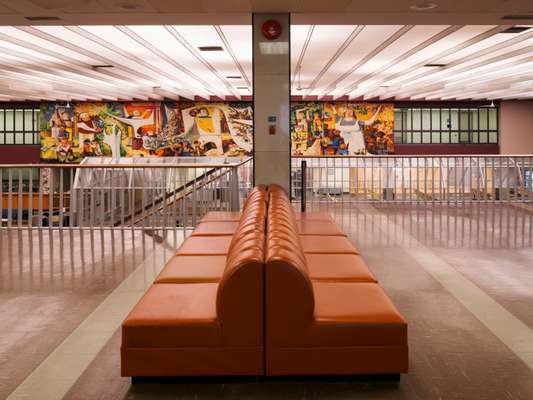
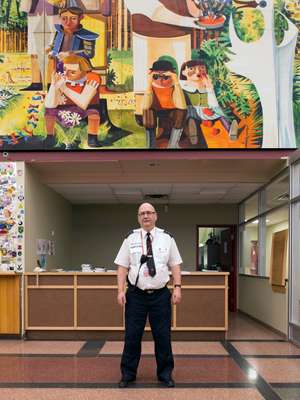

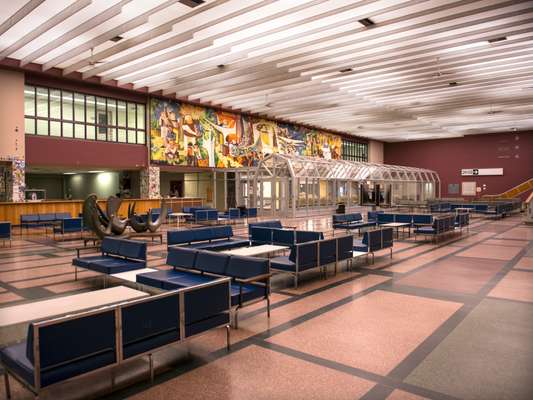
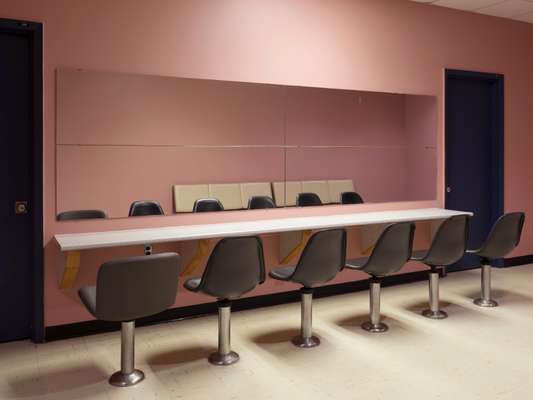
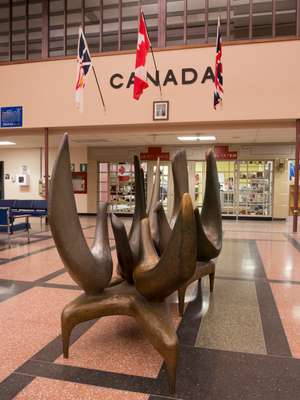
“With so many jet-setters arriving in Gander, the government wanted an up-to-date terminal but also they were fighting the international impression of Canada being backward,” says ceo Gary Vey of the then-futuristic project. “It was a way to claim, in front of the world, that the country was a beacon of style and a leader in airspace technology.”
Gander has remained largely untouched through the decades. Today the striking “Welcoming Birds” bronze sculpture by Canadian artist Arthur Price sits undisturbed in the middle of the geometric terrazzo flooring. Seamlessly aligned next to them is seating in soft grey and navy blue from Robin Bush’s Prismasteel line designed for Herman Miller.
Adding to the artistic flair, and softening the feel of the space, is the stirring 22-metre mural by Canadian artist Kenneth Lochhead. “It is bright and creates a certain liveliness to the room,” says Vey of the artwork that can be enjoyed from the comfort of the Christen Sorensen armchairs in the viewing area.
A wood-panelled escalator leads to the mezzanine floor – some say it was the first escalator in Newfoundland. Currently not functioning, it rises up under the wall clocks in the lounge, which show the current times in London, Montréal/New York and Moscow. “These cities are not randomly selected; back then they were the top destinations served by the airport,” explains Vey, reminded of Gander’s glory days when the airport was a pitstop not only for the planes but also their precious passengers. “I know people who still remember talking physics with Albert Einstein or sharing Fidel Castro’s first encounters with snow during a layover in Gander,” adds Cramm. “The locals were able to mingle with high-profile guests.”
Eames’s fibreglass chairs can still be found in the mirrored powder room, just next to the ladies’ toilets. “A lot of important people have used those chairs,” says Cramm. Indeed, hanging on the walls are photo collages of former regulars to the airport: Sinatra, Brando, Monroe, Bergman, Dean, Taylor and Burton. Those who weren’t pouting in the powder room were surely at the bar: Gander airport was granted Newfoundland’s first 24-hour alcohol licence.
Today the international terminal often remains empty for days at a time. With the development of aviation technology and jet fuel, stopovers became redundant and by the 1970s traffic slowed significantly. Yet Vey is optimistic: “Besides some ad hoc and seasonal destinations our international traffic remains relatively low, but domestic flights are up by 7 per cent,” he says. “We’re still making money – maybe not as much as we wish we made but the airport will survive, there is no doubt about it.”
Gander in numbers
1938: Airport opens as Newfoundland International airport
1959: New international terminal is built
400,000: Average annual passengers in the 1950s
30 per cent: The revenue from domestic flights in 2012
CA$7.8m (€5.6m): Annual revenues 2011–2012
3,109m: The lenagth of runway 03-21, still among the longest in North America
20,000 sq m: The size of Gander International Airport’s terminal
CA$7m (€5m): Gander’s budget in 2013
CA$536m (€387m): Gander’s contribution to the Canadian economy
4: Scheduled direct domestic routes to Toronto, Goose Bay, St John’s and Halifax
Emergency landings
Gander was put back on the world’s map on 11 September 2001 when 36 planes were diverted to the airport following the closure of US airspace. “We were the only airport around with the capacity to handle that many airplanes at once,” says CEO Gary Vey.
In the aftermath the airport and town became home to nearly 6,200 stranded passengers and 480 crew. Today, Gander often provides emergency services to airlines in cases involving mechanical issues, unruly passengers or health problems on board.

